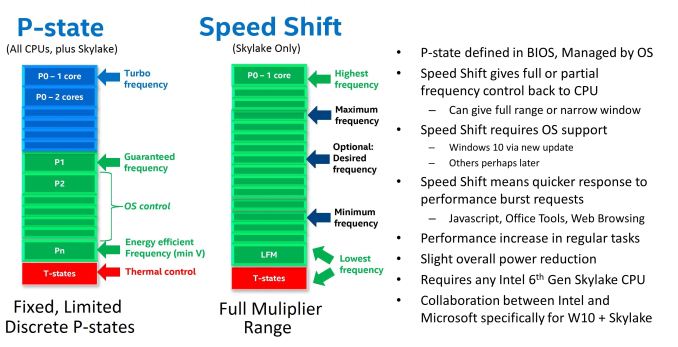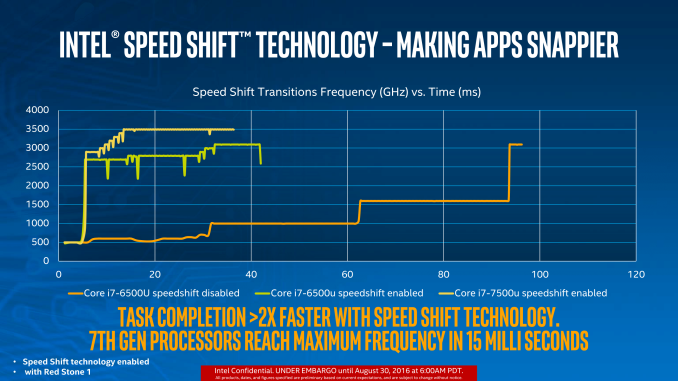The Intel Core i3-7350K (60W) Review: Almost a Core i7-2600K
by Ian Cutress on February 3, 2017 8:00 AM EST7th Generation New Features
One of the big questions regarding the launch of Intel’s 7th Generation of CPUs was around what extra features the new platform brings, especially if there isn’t any clock-for-clock performance improvement. As with our other Kaby Lake reviews, here we explain the main two: Speed Shift v2 and Optane Memory support.
Speed Shift v2
For the Intel’s 6th Generation of processors, Skylake, they introduced Speed Shift (v1). This was a feature that, at a high level, gave control of the voltage/frequency curve from the operating system to the processor. Using a series of internal metrics, such as instruction analysis and frequency, the CPU would automatically adjust the voltage and frequency of the processor as required. This afforded two major benefits: one, with the CPU in control it has access to many more points on the curve compared to the OS which is limited to specific P-states on the processor.
The second benefit is the speed of transition. A processor that can ramp up to a high frequency quickly and then drop down as needed can get through instructions quicker but also save power. Imagine driving a car, and having to wait 60 seconds to change a gear – it’s that sort of analogy.
What Speed Shift v2 does in the Kaby Lake family, compared to v1 in Skylake, is manage those transitions to higher frequency faster. Before Speed Shift, transitions from idle to peak turbo were on the order of 100 milliseconds, and Speed Shift v1 took that to 30 milliseconds (with a good base established within 15). Speed Shift v2 means that peak performance from idle now happens in 10-15 milliseconds total. This means that interactions with the OS, such as touch, or actions that rely on low latency, can occur within a couple of frames on a 60 Hz display.
The benefit of Speed Shift lies a lot in touch devices, which perhaps doesn’t affect the desktop Kaby Lake processors in this review, but also in web interactions. A lot of web work is stop and start, such as scrolling or javascript functions.
There is one caveat however – Speed Shift currently only works in Windows 10. It requires a driver which is automatically in the OS (v2 doesn’t need a new driver, it’s more a hardware update), but this limitation does mean that Linux and macOS do not benefit from it. I would be hard pressed to not imagine that Apple and Intel were not working on a macOS driver, but as yet we have not had confirmation that one exists.
Optane Memory Support
The latest memory technology to hit prime time is Intel and Micron’s 3D XPoint. This is a non-volatile form of data storage that is bit addressable and can be used as DRAM or storage. Despite being at least a decade in the making, and being formally announced in 2014, it is still yet to show up commercially as it is still being developed. Intel plans to create 3D XPoint DRAM that is slightly slower than normal DRAM but both denser (more of it) and non-volatile (keeps the data after power loss, saves power altogether), as well as 3D XPoint Storage that is faster than standard NAND flash, and more configurable. It the scheme of things, we expect the storage based products to hit the market first.
Intel, as far as we can tell, is set to release two main classes of product: Optane DRAM to be pin-compatible with DDR4 and require Optane DRAM enabled processors, and Optane SSDs which should work with any PCIe storage interface. ‘Optane Memory’ however, is something a little different. Based on pre-briefings, Optane Memory is certainly not Optane SSD we were told, but rather a storage cache for mechanical hard-drives. We’ve had this before with NAND flash drives, using Intel’s Rapid Storage Technology, and it seems that Kaby Lake and 200-series chipsets will support a new version of RST for PCIe based storage. But because this is caching drive, such as the 16GB Optane Memory drives in Lenovo’s upcoming notebooks, and not Optane SSD, might lead us to believe that ‘Optane Memory’ drives are not designed to be directly user addressable.
All that being said, Intel has stated that Optane Memory standalone drives should hit the market nearer Q3 for general consumer use, which is more in-line with what we might expect to see with Optane SSDs in the enterprise space.













186 Comments
View All Comments
forgot2yield28 - Sunday, February 5, 2017 - link
Agreed, the timing of the first ever i3 K variant just ahead of Ryzen seems more than just coincidental. Intel seems to be arguing that for value minded users, the IPC and high clocks will make this a better prospect that Ryzen's many-core and likely somewhat lower IPC. That's not new, what is new is that little K on the end meant to capture that market segment of users on a budget who still want the fun of overclocking. Before, the logic was always that intel wouldn't release an i3 K because it would canabalize i5 sales. Now they seem to be proactively guarding a piece of market share that would pick an overclockabe Ryzen chip instead of an i5. Competition is a wonderful thing!futurepastnow - Sunday, February 12, 2017 - link
"I'd say they are preemptively stacking the product deck prior to the release of AMD Ryzen"Yep, Ryzen will also launch with its high-end parts first- AMD's competitiveness will not filter down to low-end parts until 2h16. Until 2C4T Ryzen parts appear, Intel will still have a monopoly on good cheap processors so the more they can sell in that time, the better, for them.
futurepastnow - Sunday, February 12, 2017 - link
I meant 2h17 lol, I write the date a dozen times a day and still get it wrong.zeeBomb - Friday, February 3, 2017 - link
Hmm. What should I get instead of this then around the price range or cheaper?CaedenV - Friday, February 3, 2017 - link
how about a non-k i3?I mean look at the charts, they keep up just fine. Sure, you don't get overclocking capability, but you also get to save money by not needing a custom cooler ($30-50), or a z-series motherboard ($30-150), and the chips themselves are cheaper ($30-50). That saves you some $90+ on your build right there, while offering most of the performance. Either pocket the money, or spend it on a good SSD or better GPU.
stardude82 - Friday, February 3, 2017 - link
G4560... $64. Widely available now. Preforms just below a i3-6100/i5-2500 above Haswell i3s.Alexvrb - Friday, February 3, 2017 - link
If you want to go cheaper, see CaedenV's post below. If you're thinking about staying in roughly the same price range, get an entry-level i5. Something like a i5-7400. The cost of the processor itself is higher, but the total platform price will be around the same because of cost-savings elsewhere, like Caeden listed for the i3 non-K. You won't need to worry about overclocking so no need for upgraded cooling, and no need for an overclock-friendly board.CaedenV - Friday, February 3, 2017 - link
The i3 available back in the day suffered from quite a few things at the time, and had rather dramatic setbacks compared to the i5 and i7 offerings of the day. Still not bad as an entry level gaming CPU... but even it would bottleneck a mid to high range GPU at the time.But today's i3 offerings are able to offer enough performance to keep up with even today's mid to high end GPUs without problem! Part of that is the move to PCIe3, part of it is efficiency making up for a lack of cores, and part of it is simply because more and more games support HT cores where that use to not be the case.
On a win10 system there is even more advantage as it is better at off-loading background processes to less used cores, so even if your game does not take advantage of HT, windows will in order to alleviate the heavily loaded 'real' cores.
I think the really amazing thing to look at in these charts are how well the non-K i3 chips do. You can save a lot of money if you can give up OC and ~2-300 MHz. a plain-jane i3 on a B or H series chipset and a single mid to high-end GPU would game fantastically compared to a high-end i7 with z-series chip. Still not amazing for content creation (though not bad for a hobbiest)... but if all you are doing is video games, office/school work, web browsing, and watching videos then it is getting harder and harder to recommend anything other than an i3.
cocochanel - Friday, February 3, 2017 - link
I don't understand most comments. If you're gaming, an extra 50$ for an i5 is nothing. A CPU is good enough for 3-4 years. How much are you going to spend on games in that time period ? Here in Canada, Battlefield 1 Premium costs about 160$. That's just one game. How many games are you going to buy ? More than a few I guess. Besides, with DX12 and Vulkan becoming mainstream API's, a quad core is must. Just get an i5 or Ryzen and forget about it.javier_machuk - Friday, February 3, 2017 - link
Am I the only one that thinks that these test should have been between the overclocked speeds of both processors? Isn't the idea behind an unlocked processor that you overclock it?